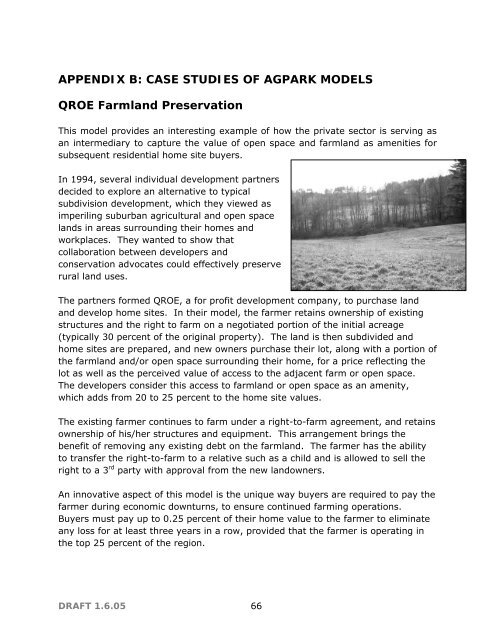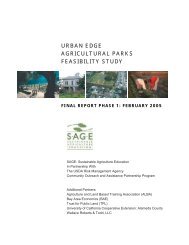A Feasibility Study for Urban Edge Agricultural Parks - SAGE
A Feasibility Study for Urban Edge Agricultural Parks - SAGE
A Feasibility Study for Urban Edge Agricultural Parks - SAGE
You also want an ePaper? Increase the reach of your titles
YUMPU automatically turns print PDFs into web optimized ePapers that Google loves.
APPENDIX B: CASE STUDIES OF AGPARK MODELSQROE Farmland PreservationThis model provides an interesting example of how the private sector is serving asan intermediary to capture the value of open space and farmland as amenities <strong>for</strong>subsequent residential home site buyers.In 1994, several individual development partnersdecided to explore an alternative to typicalsubdivision development, which they viewed asimperiling suburban agricultural and open spacelands in areas surrounding their homes andworkplaces. They wanted to show thatcollaboration between developers andconservation advocates could effectively preserverural land uses.The partners <strong>for</strong>med QROE, a <strong>for</strong> profit development company, to purchase landand develop home sites. In their model, the farmer retains ownership of existingstructures and the right to farm on a negotiated portion of the initial acreage(typically 30 percent of the original property). The land is then subdivided andhome sites are prepared, and new owners purchase their lot, along with a portion ofthe farmland and/or open space surrounding their home, <strong>for</strong> a price reflecting thelot as well as the perceived value of access to the adjacent farm or open space.The developers consider this access to farmland or open space as an amenity,which adds from 20 to 25 percent to the home site values.The existing farmer continues to farm under a right-to-farm agreement, and retainsownership of his/her structures and equipment. This arrangement brings thebenefit of removing any existing debt on the farmland. The farmer has the abilityto transfer the right-to-farm to a relative such as a child and is allowed to sell theright to a 3 rd party with approval from the new landowners.An innovative aspect of this model is the unique way buyers are required to pay thefarmer during economic downturns, to ensure continued farming operations.Buyers must pay up to 0.25 percent of their home value to the farmer to eliminateany loss <strong>for</strong> at least three years in a row, provided that the farmer is operating inthe top 25 percent of the region.DRAFT 1.6.05 66





